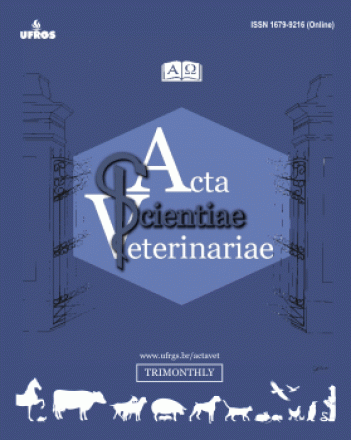Níveis séricos de progesterona em vacas ovariectomizadas tratadas com MAD4® com diferentes concentrações e vias de administração
Acta Scientiae Veterinariae
Níveis séricos de progesterona em vacas ovariectomizadas tratadas com MAD4® com diferentes concentrações e vias de administração
Autor Correspondente: Dimas Corrêa Rocha | [email protected]
Palavras-chave: progesterona, farmacodinâmica, mad-4, vacas de corte, sincronizaçã
Resumos Cadastrados
Resumo Inglês:
Background: Progesterone and synthetic progestogens are used to prepare the uterus for pregnancy, and for the hypothalamus,
pituitary and ovaries to respond to endogenous and exogenous gonadotropins. The object of this work was to check serum
progesterone concentrations in ovariectomised cows, to determine pharmacokinetics of MAD-4 ® product.
Materials, Methods & Results: A group of eigth Braford cows was divided into two groups, in two experiments. In experiment
I, both groups received 250 mg of progesterone by different routes of application: intramuscular or subcutaneous. In experiment
II, subcutaneous application was used in both groups, the differentiation of the treatments lying in the concentration of
progesterone: treatment 2 received 250 mg progesterone and treatment 3 was administered 375 mg of progesterone. In the first
24 h samples were collected in intervals of 6 hours, then every 24 h up to 192 h (day 8). In experiment I there was a significant
difference (P < 0.05) at 96 h, showing greater concentration in treatment 2 compared to treatment 1 (1.54 ng/mL vs. 0.48 ng/
mL, respectively). In experiment II, in the measures undertaken at 144 h, 168 h and 192 h with significant difference (P < 0.05),
concentrations of progesterone in treatment 2 were lower when compared to treatment 3 (0.79 ng/mL vs. 1.63 ng/mL, 0.66 ng/
mL vs. 1.36 ng/mL and 0.49 ng/mL vs. 1.11 ng/mL respectively for hours and treatments). Due to the fact that the types of
progestogens and doses used to control the estrous cycle in cattle may be less effective than endogenous progesterone (a
corpus luteum) with respect to suppression of LH, the high frequency of LH pulses results in development of “persistentâ€
follicles containing aged eggs of low fertility. In this study, the application of 250 mg of intramuscular and subcutaneous long
action injectable progesterone elevated progesterone serum concentration above 1 ng/mL. Subcutaneous application presented
levels exceeding 1 ng/mL for a longer time, from 6 to 96 h. This treatment probably suppresses LH pulses temporarily without
staying very long in the bloodstream; for this reason it doesn’t impair fertility. The same cannot be said in the treatment
situation with the application of 375 mg subcutaneous long-action injectable progesterone, because, as long as progesterone
was measured (day 8), the concentration remained higher than 1 ng/mL.
Discussion: Vaginal silicone implants impregnated with 0.5 g of progesterone, when used for the second time (7 days each
time), failed to maintain serum progesterone levels for more than 24 h higher than 1 ng/mL. In this study, treatment with 250
mg intramuscular long-action injectable progesterone showed similar serum concentrations over time, because between 24
and 48 h the levels were below 1 ng/mL. Parenteral routes of administration include, among others, the intramuscular (IM) and
subcutaneous (SC). The intramuscular route is characterised by a relatively rapid absorption via the subcutaneous, is characterized
by a slower absorption and continuous. Treatment of ovariectomised cows with long-acting injectable progesterone in
different doses and by different routes resulted in significantly different serum concentrations at some moments, characteristic
of each route of administration and doses used. In this study we can conclude that the seemingly more appropriate treatment
is that which makes use of 250 mg of long-acting progesterone, subcutaneously injected, keeping progesterone serum levels
higher than 1ng/mL per period of four days.

